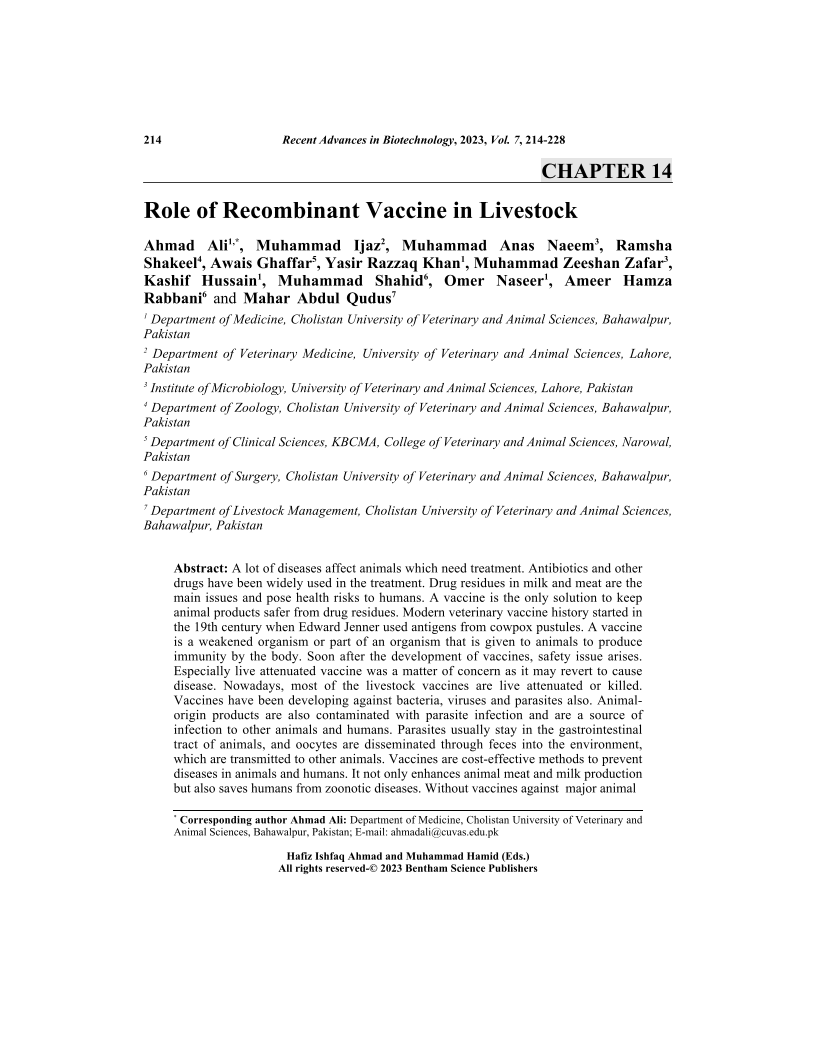Role of Recombinant Vaccine in Livestock

- Authors: Ahmad Ali1, Muhammad Ijaz2, Muhammad Anas Naeem3, Ramsha Shakeel4, Awais Ghaffar5, Yasir Razzaq Khan6, Muhammad Zeeshan Zafar7, Kashif Hussain8, Muhammad Shahid9, Omer Naseer10, Ameer Hamza Rabbani11, Mahar Abdul Qudus12
-
View Affiliations Hide Affiliations1 Department of Medicine, Cholistan University of Veterinary and Animal Sciences, Bahawalpur, Pakistan 2 Department of Veterinary Medicine, University of Veterinary and Animal Sciences, Lahore, Pakistan 3 Institute of Microbiology, University of Veterinary and Animal Sciences, Lahore, Pakistan 4 Department of Zoology, Cholistan University of Veterinary and Animal Sciences, Bahawalpur, Pakistan 5 Department of Clinical Sciences, KBCMA, College of Veterinary and Animal Sciences, Narowal, Pakistan 6 Department of Medicine, Cholistan University of Veterinary and Animal Sciences, Bahawalpur, Pakistan 7 Institute of Microbiology, University of Veterinary and Animal Sciences, Lahore, Pakistan 8 Department of Medicine, Cholistan University of Veterinary and Animal Sciences, Bahawalpur, Pakistan 9 Department of Surgery, Cholistan University of Veterinary and Animal Sciences, Bahawalpur, Pakistan 10 Department of Medicine, Cholistan University of Veterinary and Animal Sciences, Bahawalpur, Pakistan 11 Department of Clinical Sciences, KBCMA, College of Veterinary and Animal Sciences, Narowal, Pakistan 12 Department of Livestock Management, Cholistan University of Veterinary and Animal Sciences, Bahawalpur, Pakistan
- Source: Recent Advances in Biotechnology , pp 214-228
- Publication Date: July 2023
- Language: English
Role of Recombinant Vaccine in Livestock, Page 1 of 1
< Previous page | Next page > /docserver/preview/fulltext/9789815165074/chap14-1.gif
nbsp;A lot of diseases affect animals which need treatment. Antibiotics and other drugs have been widely used in the treatment. Drug residues in milk and meat are the main issues and pose health risks to humans. A vaccine is the only solution to keep animal products safer from drug residues. Modern veterinary vaccine history started in the 19th century when Edward Jenner used antigens from cowpox pustules. A vaccine is a weakened organism or part of an organism that is given to animals to produce immunity by the body. Soon after the development of vaccines, safety issue arises. Especially live attenuated vaccine was a matter of concern as it may revert to cause disease. Nowadays, most of the livestock vaccines are live attenuated or killed. Vaccines have been developing against bacteria, viruses and parasites also. Animal-origin products are also contaminated with parasite infection and are a source of infection to other animals and humans. Parasites usually stay in the gastrointestinal tract of animals, and oocytes are disseminated through feces into the environment, which are transmitted to other animals. Vaccines are cost-effective methods to prevent diseases in animals and humans. It not only enhances animal meat and milk production but also saves humans from zoonotic diseases. Without vaccines against major animal diseases, it will not be possible to feed 7 billion people with proteins. Zoonotic diseases, such as brucellosis and Leptospirosis, will be more prevalent in the world without the vaccination of animals. Rinderpest is almost eradicated from the globe and will be the second disease after smallpox which is diminished through proper vaccination and surveillance.
-
From This Site
/content/books/9789815165074.chap14dcterms_subject,pub_keyword-contentType:Journal -contentType:Figure -contentType:Table -contentType:SupplementaryData105

